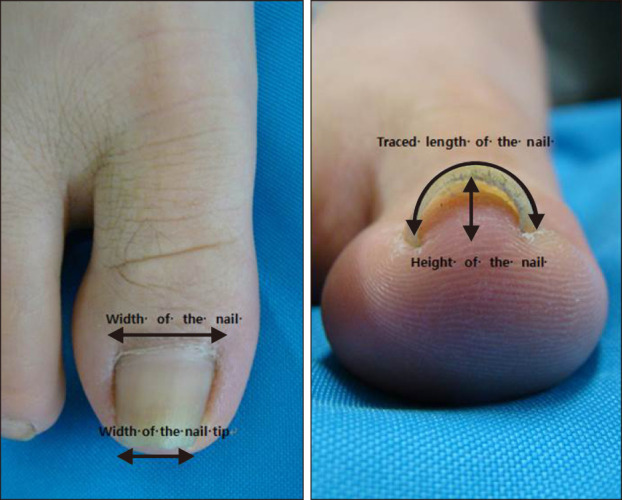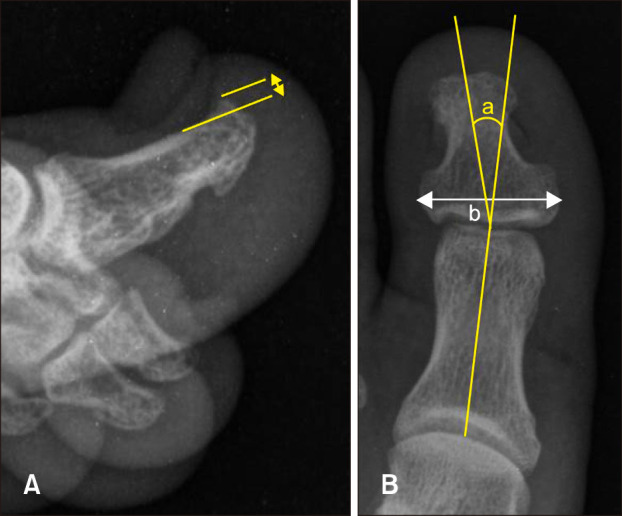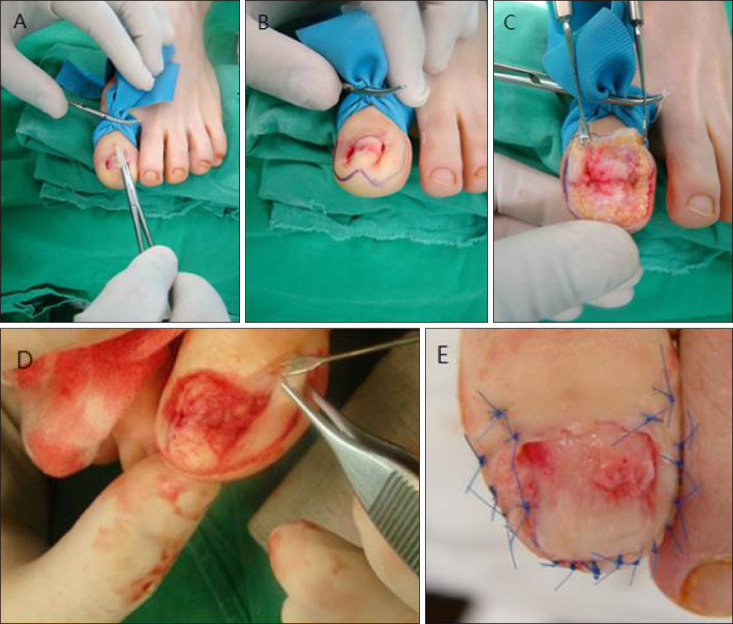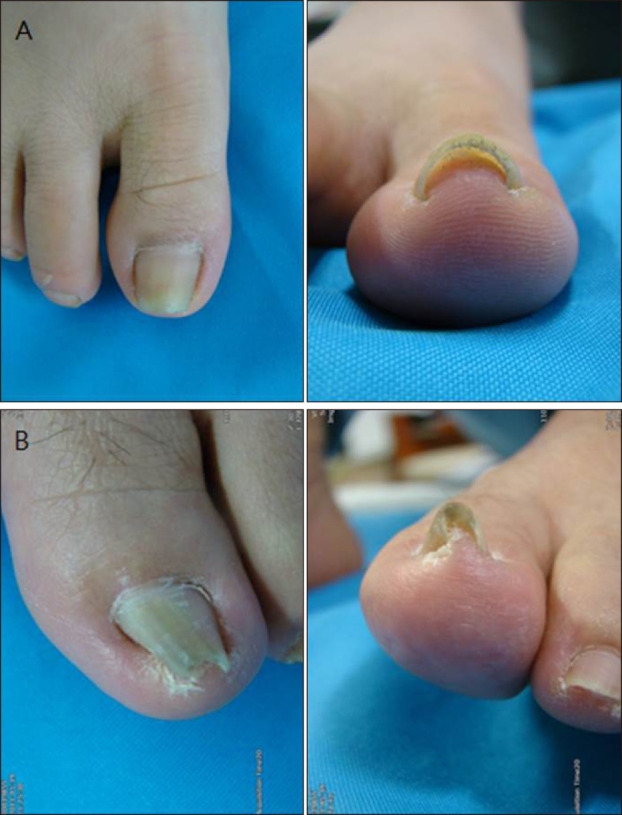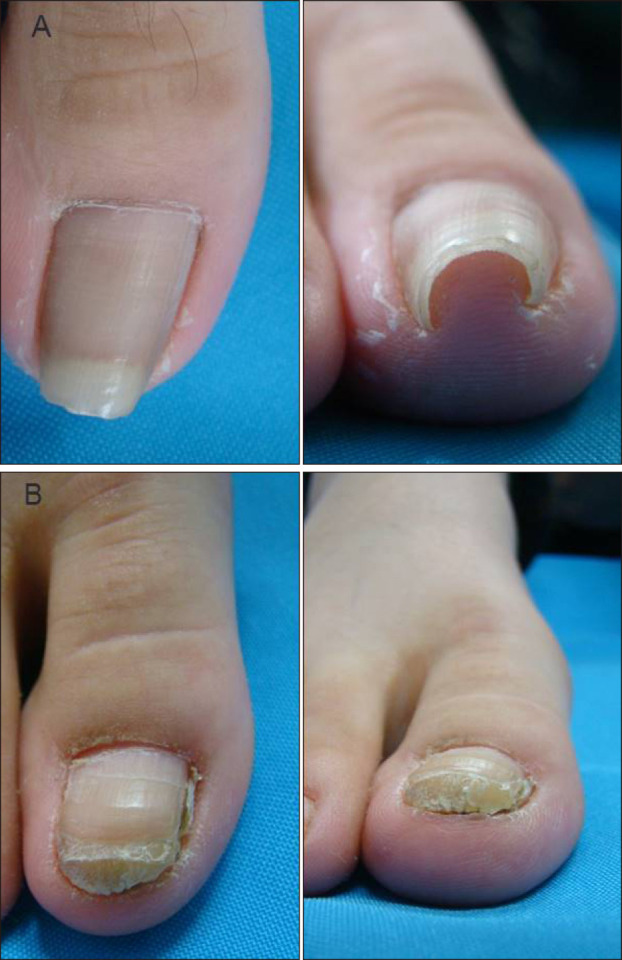Ann Dermatol.
2019 Feb;31(1):59-65. 10.5021/ad.2019.31.1.59.
Significance of Surgery to Correct Anatomical Alterations in Pincer Nails
- Affiliations
-
- 1Department of Dermatology, Wonkwang University School of Medicine, Iksan, Korea. derma@chol.com
- KMID: 2430802
- DOI: http://doi.org/10.5021/ad.2019.31.1.59
Abstract
- BACKGROUND
Pincer nail deformity and its causes can pose a therapeutic challenge. Ill-fitting shoes and subungual exostosis of the toes may be attributed to pincer nail formation. However, in some cases, the causes of pincer nail deformity could not be determined. The role of mechanobiology in nail configuration and deformities has rarely been considered.
OBJECTIVE
The present study investigated the effectiveness of surgical procedures to correct pincer nail deformity, in terms of anatomical changes measured by radiographs.
METHODS
Two surgical procedures, nail bed widening with matrixectomy or a dermal graft, were used on 30 nails in 20 patients with pincer deformity. Changes in the width, height, and curvature indices were assessed. Radiographs were obtained to evaluate the presence of osteophytes and measure the interphalangeal angle in terms of mechanobiology in nail configuration.
RESULTS
Preoperative and postoperative assessment results revealed marked improvement objectively and subjectively. The mean width index was greater after surgery than that before surgery (84.4% vs. 64.8%). Both mean height and curvature indices were smaller after surgery than before preoperative (23.0% vs. 76.7% and 1.3% vs. 2.2%, respectively).
CONCLUSION
Nail bed widening with matrixectomy, which corrects anatomical alterations in pincer nails, is suggested to be suitable for patients with pincer nail deformity.
Keyword
Figure
Reference
-
1. Cornelius CE 3rd, Shelley WB. Pincer nail syndrome. Arch Surg. 1968; 96:321–322. PMID: 5212470.
Article2. Sorg M, Krüger K, Schattenkirchner M. [The pincer-nail syndrome--a rare differential diagnosis of finger end joint-/nail involvement]. Z Rheumatol. 1989; 48:204–206. German. PMID: 2800737.3. Mimouni D, Ben-Amitai D. Hereditary pincer nail. Cutis. 2002; 69:51–53. PMID: 11829181.4. Kosaka M, Kamiishi H. New strategy for the treatment and assessment of pincer nail. Plast Reconstr Surg. 2003; 111:2014–2019. PMID: 12711965.
Article5. Yabe T. Curvature index of pincer nail. Plast Reconstr Surg Glob Open. 2013; 1:e49. PMID: 25289244.
Article6. Zook EG, Chalekson CP, Brown RE, Neumeister MW. Correction of pincer-nail deformities with autograft or homograft dermis: modified surgical technique. J Hand Surg Am. 2005; 30:400–403. PMID: 15781366.
Article7. Plusjé LG. Pincer nails: a new surgical treatment. Dermatol Surg. 2001; 27:41–43. PMID: 11231241.
Article8. VanDuzer ST, Taras J. Surgical correction of severe bilateral thumb pincer-nail deformity. J Hand Surg Am. 2006; 31:1546–1548. PMID: 17095389.
Article9. Lee JI, Lee YB, Oh ST, Park HJ, Cho BK. A clinical study of 35 cases of pincer nails. Ann Dermatol. 2011; 23:417–423. PMID: 22148007.
Article10. Ozawa T, Yabe T, Ohashi N, Harada T, Muraoka M, Ishii M. A splint for pincer nail surgery: a convenient splinting device made of an aspiration tube. Dermatol Surg. 2005; 31:94–98. PMID: 15720103.
Article11. Jung DJ, Kim JH, Lee HY, Kim DC, Lee SI, Kim TY. Anatomical characteristics and surgical treatments of pincer nail deformity. Arch Plast Surg. 2015; 42:207–213. PMID: 25798393.
Article12. Baran R, Haneke E, Richert B. Pincer nails: definition and surgical treatment. Dermatol Surg. 2001; 27:261–266. PMID: 11277894.
Article13. Kosaka M, Kusuhara H, Mochizuki Y, Mori H, Isogai N. Morphologic study of normal, ingrown, and pincer nails. Dermatol Surg. 2010; 36:31–38. PMID: 19889164.
Article14. Forslind B, Thyresson N. On the structure of the normal nail. A scanning electron microscope study. Arch Dermatol Forsch. 1975; 251:199–204. PMID: 1115523.15. Kosaka M, Asamura S, Wada Y, Kusada A, Nakagawa Y, Isogai N. Pincer nails treated using zigzag nail bed flap method: results of 71 toenails. Dermatol Surg. 2010; 36:506–511. PMID: 20187902.16. Maeda N, Mizuno N, Ichikawa K. Nail abrasion: a new treatment for ingrown toe-nails. J Dermatol. 1990; 17:746–749. PMID: 2086619.
Article17. Roh DK, Lee DW, Cho BK. A case of heredetary pincer nail treated with nail grinding method. Korean J Dermatol. 1997; 35:971–974.18. Kim JY, Park SY, Jin SP, Yoon HS, Cho S, Park HS. Quick and easy correction of a symptomatic pincer nail using a shape memory alloy device. Dermatol Surg. 2013; 39:1520–1526. PMID: 24090262.19. Haneke E. Pincer nails. In : Krull EA, Zook EG, Baran R, Haneke E, editors. Nail surgery: a text and atlas. Philadelphia: Lippincott Williams & Wiklins;2001. p. 167–171.20. Park SH, Kim EJ, Park K. The effectiveness of surgical correction of pincer nails using nail bed flap and bilateral partial matrixectomy, with or without osteophyte removal. Korean J Dermatol. 2015; 53:773–779.
- Full Text Links
- Actions
-
Cited
- CITED
-
- Close
- Share
- Similar articles
-
- Two Cases of Pincer Nails Treated by Elastic Wire and Thioglycolic Acid
- A Case of Pincer Nail Treated with Nail Plate Separation
- Nail Plate and Bed Reconstruction for Pincer Nail Deformity
- COâ‚‚ Fractional Laser and Topical Therapy on Pincer Nails
- A New Treatment for Severe Incurved Toenail(2 Cases Report)

